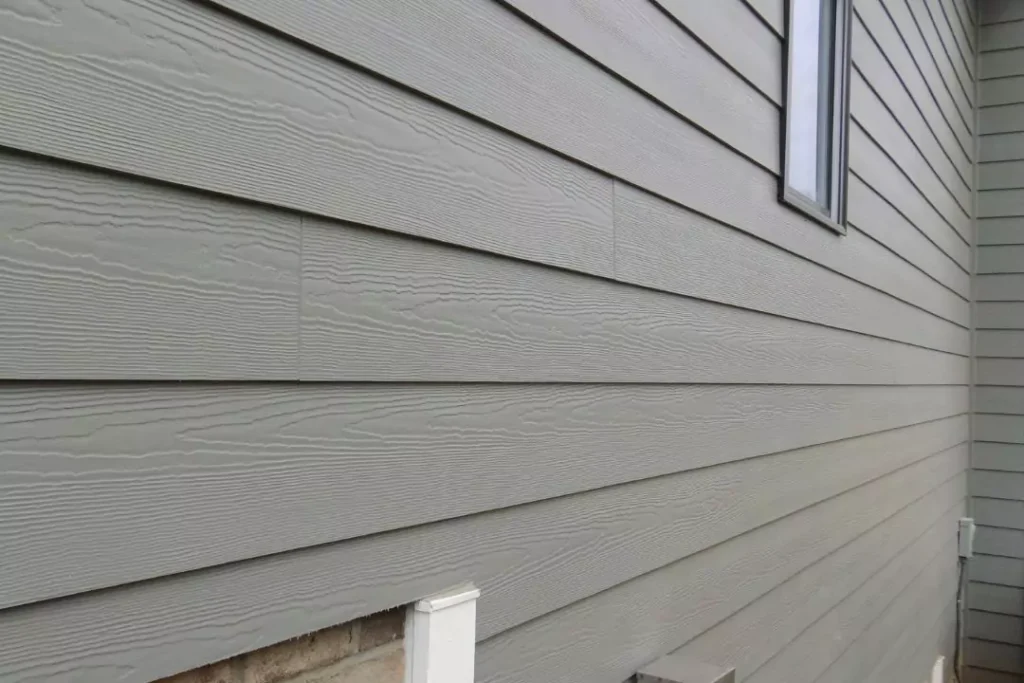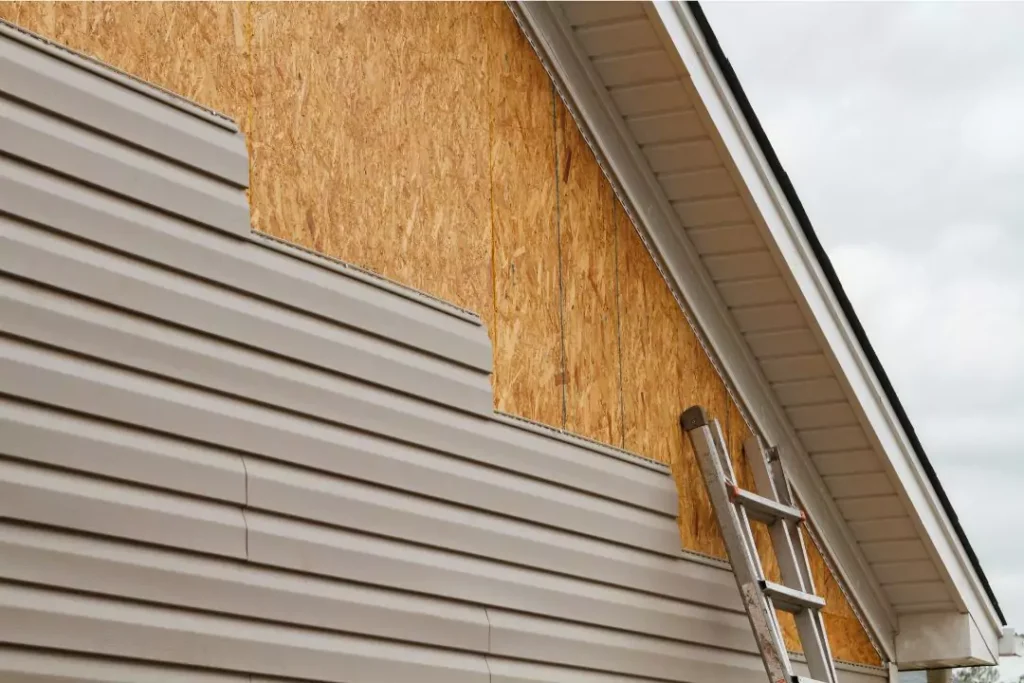Over the past 30 years, vinyl siding has become extremely popular in our country. As it is estimated, about 50% of the buildings in the United States are just covered with vinyl, fiber cement siding or wood. Although we recently prepared an article on choosing a siding material, this time we decided to compare two specific technologies. So let’s see if fiber cement siding is better than vinyl siding, and if so, why.
Table of Contents
What is Fiber Cement Siding?

Fiber cement is a synthetic material used for siding. Its composition is relatively simple – it is a mixture of cement, sand, water and cellulose, which replaced the asbestos used in the past. Fiber cement is a fairly rigid material, but its parameters are markedly different from those of concrete. Cellulose fibers give the siding flexibility, which protects it from cracking and crumbling. Add that fiberboard siding can be sold in the form of boards or shakes.
Hardieboard, Hardie board siding or HardiePlank are common trade names for this material – they refer to the popular brand name James Hardie. Let’s also point out that the vast majority of fiber cement cladding boards have a wood texture. This effect is achieved by imprinting the boards in the material during production.
What Is Vinyl Siding?

Vinyl siding is panels or boards manufactured from PVC, or polyvinyl chloride. For many years, this material has been extremely popular in the United States because of its relatively high flexibility, low price, low maintenance requirements and high customization possibilities.
What are the Current Trends in the Siding Market?

As the attached illustration shows, vinyl siding still dominates in many areas of the United States. It is particularly popular on the East Coast and in the north-central part of the country. It’s worth noting, however, that just 20-30 years ago, the prevalence of PVC was even more pronounced. Only for the past decade or so have homeowners increasingly opted for fiber cement siding, which has been convincing for its fire-resistance, low maintenance needs and stunning appearance.
In many areas of the United States, fiber cement siding is not popular not so much because of its price, but rather because of local architectural traditions. The choice of cladding material is also influenced by energy prices – if electricity is expensive, homeowners look for products with better insulation performance and are willing to pay more for it.
Fiber Cement Siding vs Vinyl Siding – Comparison
Let’s start by comparing the key features of the two materials.
1. Durability
The first major difference found between vinyl and fiber cement siding is their resistance. Fiberboards, which are made from a mixture of sand, cement, water and cellulose fibers, are distinguished by their high resistance to weathering as well as to impacts, such as hail, falling branches and birds.

On the other hand, vinyl siding is usually thinner, and the PVC used in its production is much more flexible, reducing the risk of cracking and breaking. However, it is worth remembering that vinyl can tear and sometimes even crack, especially if the material is already quite old and has been exposed to UV radiation for a long time. Usually, vinyl siding repairs are not cost-effective and it is necessary to replace the entire wall cladding. This is, of course, quite expensive.
In terms of durability, fiber cement siding is definitely superior to vinyl.
2. Longevity
Fiber cement siding has become widespread relatively recently, but it is estimated that its lifespan is 40 to 60 years. Note, however, that most siding made with this technology comes with a 20-30 year warranty, so it can be assumed that replacement may be necessary after about 4 decades after installation.
In the case of vinyl siding, the lifespan is noticeably worse – it is said that in heavily sunny areas, PVC lasts only 10 years, but in practice, the service life of vinyl is about 2 decades.

According to Chris Ryba, our wall cladding specialist, vinyl siding has a shorter lifespan due to its much worse weather resistance. When exposed to UV radiation, the bonds between monomers in the PVC structure break down, and thus, vinyl loses its natrual elasticity. Over time, when the material is impacted by strong winds or something hits it, the structure cannot withstand the pressure and cracks. In addition, degradation resulting from UV exposure results in fading or yellowing, which negatively affects the curb appeal of your home.
In terms of longevity, fiber cement siding outclasses vinyl.
3. Colors and Design Options
For reasons we don’t understand, vinyl siding is sold almost exclusively in shades of white and gray. Although brands such as Gentek offer dozens of vibrant and interesting colors, customers stick firmly to conservative and classic compositions.
For fiber cement siding, brands such as James Hardie Glenview also offer a wide range of colors. The staining and texturing technology is basically very similar to that of vinyl cladding – the only limitation is your imagination and the manufacturer’s offerings.
When it comes to color availability and design options, fiber cement and vinyl siding are very comparable.
Recommended for you: Why is James Hardie so Popular in the U.S?
4. Sustainability
More and more homeowners are paying attention to the environmental impact of their homes. This trend is also noticed by companies, which are making more and more efforts to ensure that as little pollution as possible is emitted in the production of their products. Keep in mind, however, that the emissivity of production is important, but the longevity of the siding material in question and its recyclability are also important.

The production of fiber cement siding requires the use of large amounts of energy, but this is compensated by the long life of the material. Add, however, that fiber cement boards are essentially non-recyclable – just like concrete, used fiber siding can only be used as rubble.
According to Nichiha, vinyl siding production involves the emission of VOCs (volatile organic compounds) and greenhouse gasses, including DEHP. The production of vinyl is therefore harmful to the environment, and its short lifespan does not improve the situation, but in return, it is relatively easy to recycle the waste generated after changing the siding.
In this case, we can’t point to a better material, but it seems to us that fiberboards are more environmentally friendly than vinyl siding.
5. Water and Fire Resistance
When choosing siding material, you should definitely pay attention to its resistance to water and fire – this has a huge impact on your family’s level of safety.
Since fiber cement siding is de facto made of concrete, it is characterized by a very high resistance to both water and fire – admittedly, cellulose fibers can burn and shrink when exposed to temperature, but the overall structure of the panels manufactured mainly from cement will remain constant. Fire will spread, but it will happen very slowly, making it easier to extinguish the fire.

Vinyl siding is also water resistant, but its resistance to fire and high temperatures is much worse. In extreme cases, heated PVC can also catch fire, which will not occur with cement.
In terms of heat and water resistance, fiber cement siding wins over PVC.
6. Maintenance
As an Evanston siding contractor, we have to admit that homeowners often neglect the maintenance of their wall cladding.
Virtually every material requires regular inspection and use of maintenance substances – both vinyl, wood and fiber cement siding will have a much higher lifespan if they are regularly varnished, painted or washed.

In the case of fiber cement, maintenance is basically just washing the walls with a soft brush and water mixed with detergent. This is very easy and not very challenging.
In the case of vinyl siding, maintenance is similar, but the mechanical properties of this material mean that you need to pay much more attention to the process to avoid damage. Using too hard a brush can scratch the vinyl, increasing the risk of cracks.
7. Upfront Cost
The price of fiber cement siding is noticeably higher than vinyl siding. Differences can be as high as 50%, with PVC siding installation on an average-sized home costing you between $15,000 and $25,000, while fiberboard siding will generate a cost of $23,000 to as much as $35,000.
Consider, however, that the price of fiber cement is contingent on the much greater durability and longer lifespan of this product. In our opinion, a difference of 30, 40, or even 50% in price is simply an investment in up to 2x longer trouble-free life and mental comfort, which justifies the expense.
8. Painting
Although it happens relatively rarely, some homeowners choose to change the color of their siding. This is a good and simple way to visibly change the appearance of the entire house, which can improve curb appeal.
In terms of ease of painting, fiber cement turns out to be slightly better – the structure of the material is more porous, which makes it easier to cover it with various types of coatings. Varnishing and staining is also possible, although in our opinion, it is completely unnecessary.
PVC siding can also be painted, although this requires more work in preparing the material. By not properly applying paint or varnish, you can easily damage the vinyl – make sure that the solvent used by the coating manufacturer can be used for contact with polymers, because otherwise, you could literally dissolve your siding.
Is Fiber Cement Siding Better Than Vinyl Siding?
Yes, fiber cement siding is definitely superior to solutions created with older technologies, including vinyl. However, it is worth noting that while the differences are visible to the naked eye, the advantage of fiberboard siding over PVC is less than many manufacturers and distributors would like.
Indeed, siding made of fiber cement is more durable, will last longer and is potentially safer in the event of potential fires. The roughly 50% higher price is also justified, as the lifespan will be up to 3 times longer, but vinyl siding can be a good budget alternative that, provided it is properly maintained and used as intended, should do the job and protect your home’s interior well.
Best Vinyl Fiber Cement Siding Brands
At the very end, it is worth touching on the most reputable brands. As a reputable siding contractor from Glenview, we recommend using:
| Fiberboard Siding Brands | Vinyl Siding Brands |
| James Hardie | CertainTeed Siding |
| Allura | Ply Gem Siding |
| GAF | Norandex |
| Nichiha | Royal Siding |
| Woodtone |
Let’s not kid ourselves – in the vast majority of cases, homeowners opt for James Hardie anyway when they are looking for fiber cement products and CertainTeed when they are looking for siding made of vinyl. This is due to both the popularity of these brands and the quality of their products. Choosing a well-known brand, while probably more expensive, also helps maintain or increase the value of your home.

